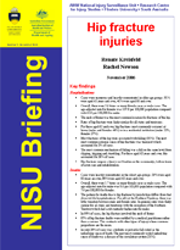Summary
Hospitalisations
- Cases were numerous and heavily concentrated in older age groups. 91% were aged 65 years and over, 40% were aged 80 and over.
- Overall, there were 2.6 times as many female cases as male cases. The age-adjusted rate for females was 107.8 per 100,000 population compared with 65.0 per 100,000 for males.
- The neck of femur was the most common location for fractures of the hip.
- Rates of hip fracture were fairly similar for all states and territories.
- For those aged 65 and over, hip fractures most commonly occurred at home (males and females 44%) or in a residential institution (males 22%, females 27%).
- Most fractures of the hip were associated with falling (91%). The next most common external cause of hip fractures was transport which accounted for 3% of cases.
- The most common mechanism of falling was a fall on the same level from slipping, tripping and stumbling. For those aged 65 years and over, this accounted for 36% of cases.
- Hip fractures impose a heavy cost burden on the community, both in terms of acute care and rehabilitation.
Deaths
- Cases were heavily concentrated in the oldest age groups. 59% were aged 85 years an over, 98% were aged 65 years and over.
- Overall, there were 1.7 times as many female cases as male cases. The age-adjusted rate for males was 8.0 per 100,000 population compared with 7.6 per 100,000 for females.
- The pattern for deaths due to hip fractures by jurisdiction differs from that observed for hospitalisations. For all but the Northern Territory, there was little variation between male and female rates. In general, rates were fairly similar for all states and territories with the exception of the Northern Territory which had a substantially higher rate for males.
- In 99% of cases, the hip fracture involved the neck of femur.
- 87% of hip fracture deaths were certified by a medical practitioner rather than a coroner. This contrasts with other types of injury where converse proportions are the norm.
- In only 39% of cases was a definite or probable fall coded as the underlying cause of death. The next most commonly coded underlying cause of death was a disease of the circulatory system (31%).



